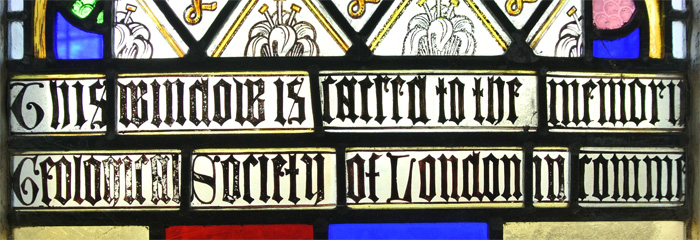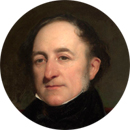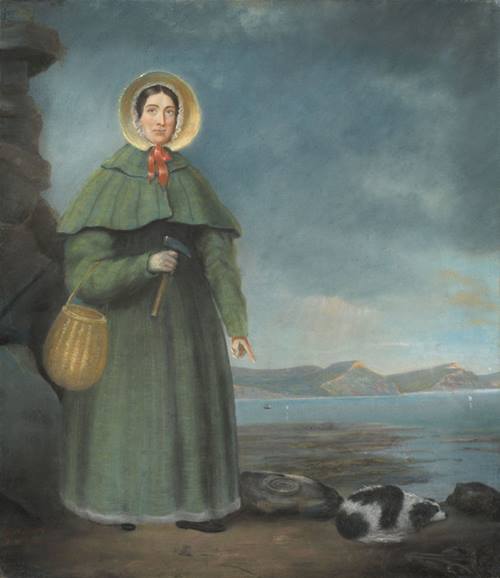
|
Detail of the Anning memorial window installed at St Michael’s Church, Lyme Regis in 1850, paid for in part by contributions made by a number of Fellows of the Geological Society. Photograph taken by Archivist, 2013. Click to enlarge.
|
In October 1842, Molly Anning died leaving her daughter Mary to run the shop on her own. The larger finds had all but dried up and even the ones which were found did not bring in the income they once did. Her fossilising activities were restricted by the symptoms of breast cancer from which she suffered from in the last few years of her life. Her geological friends once again rallied around to fundraise a further two annuities for her in 1846 but she did not live very long to enjoy the benefits. Mary Anning died on Tuesday 9 March 1847.
It is tradition at the Geological Society’s Annual General Meetings that the President reads out the names of Fellows who have died the previous year to those assembled. At the Anniversary Meeting of 18 February 1848, the serving President was Henry De la Beche. In a break from the norm, he paid tribute to his friend of nearly 35 years:
“I cannot close this notice of our losses by death without adverting to that of one, who though not placed among even the easier classes of society, but who had to earn her daily bread by her labour, yet contributed by her talents and untiring researches in no small degree to our knowledge of the great Enalio-saurians, and other forms of organic life entombed in the vicinity of Lyme Beds.
 MARY ANNING was the daughter of Richard Anning...From her father, who appears to have been the first to collect and sell fossils in that neighbourhood, she learnt to search for and obtain them. Her future life was dedicated to this pursuit, by which she gained her livelihood; and there are those among us in this room who know well how to appreciate the skill she employed, (from her knowledge of the various works as they appeared on the subject,) in developing the remains of the many fine skeletons of Ichthyosauri and Plesiosauri, which without her care would never have been presented to comparative anatomists in the uninjured form so desirable for their examination.
MARY ANNING was the daughter of Richard Anning...From her father, who appears to have been the first to collect and sell fossils in that neighbourhood, she learnt to search for and obtain them. Her future life was dedicated to this pursuit, by which she gained her livelihood; and there are those among us in this room who know well how to appreciate the skill she employed, (from her knowledge of the various works as they appeared on the subject,) in developing the remains of the many fine skeletons of Ichthyosauri and Plesiosauri, which without her care would never have been presented to comparative anatomists in the uninjured form so desirable for their examination.
The talents and good conduct of Mary Anning made her many friends ; she received a small sum of money for her services, at the intercession of a member of this Society with Lord Melbourne, when that nobleman was premier. This, with some additional aid, was expended upon an annuity, and with it, the kind assistance of friends at Lyme Regis, and some little aid derived from the sale of fossils, when her health permitted her to obtain them, she bore with fortitude the progress of a cancer on her breast, until she finally sunk beneath its ravages on the 9th of March, 1847." Extract from the Presidential Address of Sir Henry De la Beche, 18 February 1848, published in the Quarterly Journal of the Geological Society, vol 4 (1848), ppxxiv-xxv.
In 1850 a set of stained glass windows were unveiled at St Michael’s Church, Lyme Regis. This lasting memorial to Mary Anning, paid for in part by contributions from her friends who were Fellows of the Geological Society, can still be seen to this day.

|
| Portrait of Mary Anning by Benjamin Donne, 1850. Archive ref: GSL/POR/1. |
Another memorial of sorts is to be found in the Geological Society's Entrance Hall. This famous portrait of Mary Anning by Benjamin Donne was created three years after her death. It is based on the 1842 painting probably by William Gray (1818-fl 1883) which is held by the Natural History Museum. The artist, Benjamin Merifield Donne (1831-1928), moved to Lyme Regis in 1841 as a pupil at George Roberts’ school in Monmouth House, Broad Street. The school was close to Mary Anning's shop so he knew her well.
In the portrait, Anning is seen standing in front of the headland Golden Cap, the highest point on the south coast of England. Her faithful dog is seen sleeping at her feet. She is holding her geological hammer and basket, and pointing towards an ammonite embedded in a rock on the shore. Beside her dog you can just make out an ichthyosaur skull.
The portrait was purchased by one of Anning's regular customers, William Willoughby Cole, 3rd Earl of Enniskillen in 1875 from James Marder, a fossil collecting chemist based in Broad Street, Lyme Regis as a gift to the Geological Society.

|
| Mary Anning's single publication. Click to read it. |
Anning is known to have only one, brief item published under her own name. This absence of authorship in the geological literature is likely to have contributed in part to her achievements becoming obscured after her death. Her private papers and books were sold by various relatives scattering what very few things survived. Some material was acquired by Richard Owen and subsumed into his own vast personal collection. After Owen’s death, the material was further dispersed and much of it is now lost. It is only in the modern period that her activities are being reassessed and brought to light once more, through the archives and contemporary publications of her customers, many of whom were Fellows of the Geological Society.